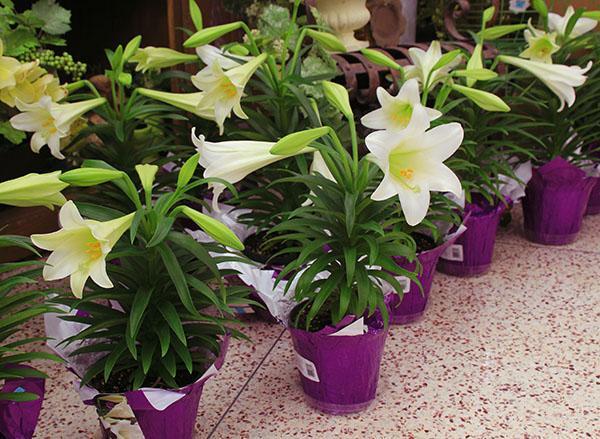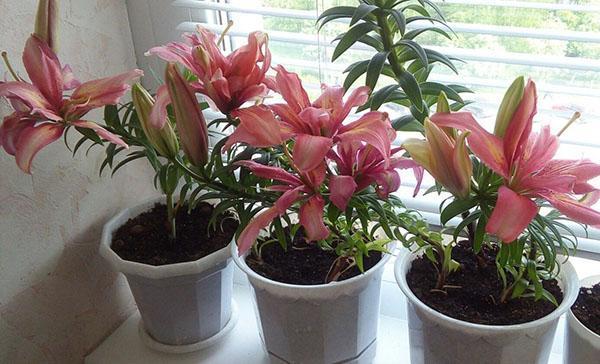Planting and caring for a room lily at home
 The house lily is one of the most beloved houseplants. It is not uncommon to be found on the windowsills of both residential and office buildings. The flower has earned its popularity thanks to its large, bright buds. It differs from its garden counterparts, first of all, in size. But beautiful, regular flowering is possible only with proper care and planting.
The house lily is one of the most beloved houseplants. It is not uncommon to be found on the windowsills of both residential and office buildings. The flower has earned its popularity thanks to its large, bright buds. It differs from its garden counterparts, first of all, in size. But beautiful, regular flowering is possible only with proper care and planting. 
How to plant a lily?
 At home, this plant blooms in the same way as in the garden - during the summer months. Therefore, it is planted in early spring. Several bulbs can be placed in a container at once. But you should adhere to the rule: one copy needs at least twenty centimeters of space.
At home, this plant blooms in the same way as in the garden - during the summer months. Therefore, it is planted in early spring. Several bulbs can be placed in a container at once. But you should adhere to the rule: one copy needs at least twenty centimeters of space.
When buying bulbs, be sure to carefully consider them. A healthy specimen should not be wrinkled or have brown spots.
The landing itself consists of several stages. If you adhere to all the rules, then the plant will quickly take root.
Planting process:
- The bulb should be disinfected first. To do this, it is necessary to make a weak aqueous solution of potassium permanganate and place the planting material in it. Hold the tuber in the liquid for about twenty minutes and put on a napkin. The bulb should dry out a little.
- Drainage should be placed on the bottom of the planting container. It can be crushed stone, ordinary broken brick or expanded clay.
- Further, the soil mixture is poured onto the drainage. You can buy soil for lilies both in the store and prepare yourself. In the second case, you will need to mix two parts of sod land and one at a time - humus, peat and sand.

- After that, a depression is made in the soil into which the bulb lies. But it must be positioned so that after falling asleep, half of it is above the surface. The earth is compacted around.

- The flower pot should be placed on a windowsill where a lot of light falls.
It is necessary to choose a container for a lily taking into account the characteristics of the variety. That is, the larger the adult plant, the deeper you need to take the pot for it.
Care and fertilization
 Proper care is important for everyone indoor plants... Including lilies. These flowers are not very moody. But the beautiful appearance of plants and the abundance of flowering depend on how comfortable conditions will be created for them. Photos of indoor lilies care at home are presented below.
Proper care is important for everyone indoor plants... Including lilies. These flowers are not very moody. But the beautiful appearance of plants and the abundance of flowering depend on how comfortable conditions will be created for them. Photos of indoor lilies care at home are presented below.
 Therefore, if you decide to grow lilies on the windowsill, carefully monitor the following factors:
Therefore, if you decide to grow lilies on the windowsill, carefully monitor the following factors:
- Watering. Irrigation should be regular and moderate. Too much waterlogging or prolonged drought will negatively affect the condition of the flower.
- Airing. Indoor lily flower does not accept dry and "stagnant" air. Therefore, the room where such a plant is located must be regularly ventilated. But it is impossible for the flower to be in a draft.

- Lighting. All liliaceae are photophilous. For the normal development and flowering of such a plant, a sufficient amount of light is needed. Therefore, the lily pot is recommended to be placed on the windows on the south side. But during lunch, when direct sunlight is especially hot, the flower should be shaded.
- Loosening. This is one of the prerequisites for leaving. Regularly performing this procedure will provide oxygen to the roots.It is necessary to loosen the earth to a depth of no more than five centimeters, otherwise the roots can be damaged.
- Fresh air. In warmer months, the indoor lily can be taken out onto the balcony or veranda. The main thing is to protect her from the scorching sun and make sure that she does not stay outside when the air temperature drops below ten degrees.
- Spraying. It is necessary to irrigate the plant regularly from a spray bottle. This will ensure that the foliage grows quickly and looks beautiful.

- Garter. If a lot of buds have formed on the stem, it is necessary to put a support and tie a flower. This will strengthen the stem so it won't break under its own weight.
As for fertilization, they must be applied during the growing season. For this, it is recommended to use special formulations designed specifically for liliaceae. These can be purchased from a specialist store. Feeding with organic matter is also possible. Before the buds appear, this should be done every ten days. After the beginning of flowering, the number of such procedures should be reduced to once a month.
 You should also pay special attention to caring for the room lily at home after flowering. At the end of budding, the upper part of the culture gradually dies off, and the bulb itself goes into a state of dormancy. You do not need to cut off the yellowed stem. During this period, it is recommended to reduce the number of waterings by half. And the irrigation from the spray gun - stop completely.
You should also pay special attention to caring for the room lily at home after flowering. At the end of budding, the upper part of the culture gradually dies off, and the bulb itself goes into a state of dormancy. You do not need to cut off the yellowed stem. During this period, it is recommended to reduce the number of waterings by half. And the irrigation from the spray gun - stop completely.
For the winter, it is recommended to put the bulb in a room where the air temperature does not rise above five degrees. If this is not possible, it is removed from the pot, put in a bag with sawdust and placed in the refrigerator.
Diseases and pests
 Most often, home lilies are subject to fungal diseases. Basically, such problems appear when the owners are too zealous with watering. In the majority of cases, the room lily is affected by gray rot. The presence of such a disease is indicated by mold spots on the leaves and stem of the flower. If gray rot is found, all damaged parts of the plant should be removed. And healthy areas are sprayed with a solution of copper sulfate.
Most often, home lilies are subject to fungal diseases. Basically, such problems appear when the owners are too zealous with watering. In the majority of cases, the room lily is affected by gray rot. The presence of such a disease is indicated by mold spots on the leaves and stem of the flower. If gray rot is found, all damaged parts of the plant should be removed. And healthy areas are sprayed with a solution of copper sulfate.
Bulbs can also be affected by a similar fungus - soft rot. This disease affects the tubers as dark, watery spots. At the same time, the bulb becomes soft and moldy. An overly affected specimen cannot be saved. In case of partial damage, it can restore the viability of the culture. To do this, you need to mix coal with sulfur, remove the onion from the ground and process it with this mixture. Then put it in a horny solution for half an hour, stretch it out and let it dry.
Also, a lily houseplant can be subject to a disease such as mosaic. The first signs appear in the form of enlightenment along the veins. In the future, such spots become whitish or yellow. Their number is increasing. And as a result, the entire sheet disappears. It occurs due to damage to chloroplasts and destruction of chlorophyll. Tissues are affected at the cellular level. Infection occurs as a result of the transfer of a virus from one plant to another. For example, after using the same instruments without disinfection. There are no anti-mosaic drugs. When this disease occurs, the plant is destroyed.
But complex diseases in indoor lilies, photos and names of which are presented in this article, rarely occur. Most often, improper care leads to problems with growing. Therefore, if you notice any aesthetic deviations in the development of the plant, just correct the regime.
 A few tips for care:
A few tips for care:
- If the bulb starts to rot, change the soil and reduce the amount of watering. Also, lack or a small amount of drainage can lead to similar problems.
- If the plant turns yellow, becomes dull, it may lack moisture. In this case, the number of irrigations should be increased.
- At home, lilies are rarely affected by insects. But, if this does happen, treat the plant with a special preparation.
Growing and caring for a room lily is not difficult and interesting. With proper planting and care, the plant will delight with beautiful green leaves and large bright buds.